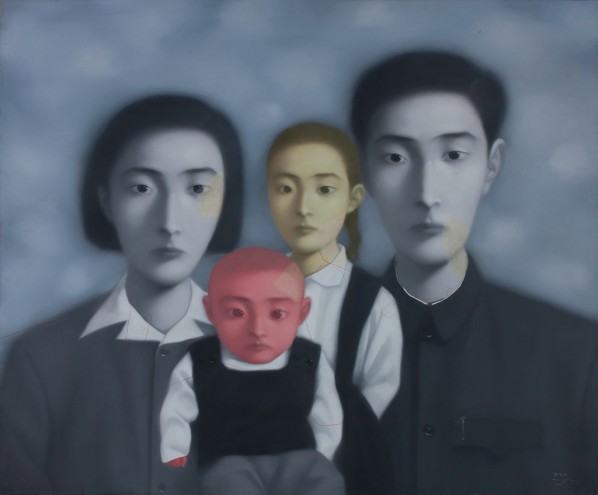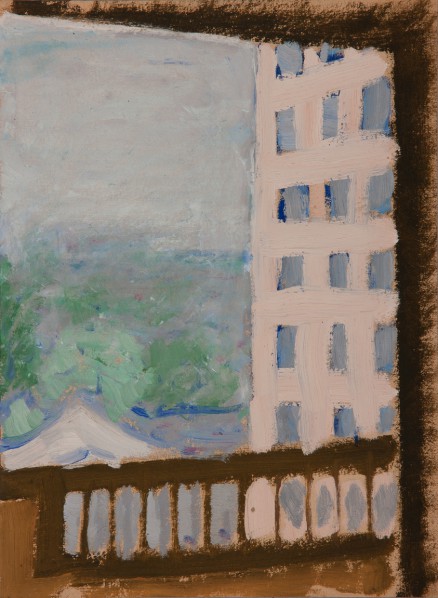
Zhang Xiaogang, Bloodline Series-Big Family No. 17, 1998; Oil on canvas, 149x180.5cm; M+Sigg Col
M+, West Kowloon Cultural District, announces the tenth edition of the Mobile M+ exhibition series M+ Sigg Collection: Four Decades of Chinese Contemporary Art will take place at ArtisTree in Taikoo Place from 23 February to 5 April 2016 with the support of Leading Sponsor Credit Suisse.
M+ Sigg Collection: Four Decades of Chinese Contemporary Art is a rigorously curated exhibition of highlights from the M+ Sigg Collection, the largest and the most comprehensive assemblage of Chinese contemporary art in the world, which formed part of the collection of Swiss collector Dr Uli Sigg. This research-based exhibition spans forty years and is the first to tell the fascinating stories behind the emergence and the development of Chinese contemporary art in a chronological format. Comprising more than 80 works of various formats and mediums, including painting, ink art, sculpture, photography, video and installation, the exhibition reflects the changing social era: from the efforts of self-organised collectives, including the No Name Group and Stars Group of the late Cultural Revolution operating on the periphery of the society and outside mainstream discourse, through the radical experiments of Cynical Realism and Political Pop artists under the influenc e of western consumerism in the 1990s, to the consciousness of the artists of the Olympic era bifurcated between East and West, traditional and modern and social engagement; these works are a selection of seminal pieces of contemporary Chinese art history, as well as examples from the vibrant art scene of present-day China.

Fang Lijun, Untitled, 1995; Oil on canvas, 250x180cm; M+Sigg Collection, Hong Kong (By donation); Courtesy of the artist and West Kowloon Cultural District Authority
The exhibition follows a three-chapter approach. The first chapter (1974–1989) introduces underground artistic experiments from No Name Group and Stars Group of the last years of the Cultural Revolution and the 85 New Wave such as the Pond Society, the Northern Art Group and Xiamen Dada, and the development up to the exhibition China/Avant-Garde in 1989. It reveals how the artists manifested self-expression and autonomous thinking, which resulted in an ideological tug of war with the mainstream social realistic arts until the end of the Cold War in 1989.
The second chapter (1990–1999) examines artistic practices and diversity during the post-Cold War era in China. The government’s determination to promote urbanisation and consumerism provided an opportunity for artists to reposition themselves in an international context, particularly within the art market. Yet, this newfound identity triggered cultural anxiety and gave rise to more radical experiments in performance, photography, video, and conceptual art during the mid-1990s.

Zhang Peili, X Series No. 4, 1987; Oil on canvas, 180x198cm; M+Sigg Collection, Hong Kong; Courtesy of the artist and West Kowloon Cultural District Authority
The final chapter (2000–present) centres on works produced in the pre- and the post-Olympic era, during which China encountered the unprecedented acceleration of globalisation and urbanisation. Artists became conscious of the consequences brought on by these rapid developments; as a result the interpretation of Chinese art and its production shifted from a purely political viewpoint to include new everyday vocabulary. Some artists began to forge a new relationship with tradition, while many others re-entered the arena of ‘social engagement’ in response to the socio-political reality that China faces today.

Zhang Wei, Fusujing Building, 1975; oil on paper, 26x19cm; M+Sigg Collection, Hong Kong, Courtesy of the artist and West Kowloon Cultural District Authority
The M+ Sigg Collection: Four Decades of Chinese Contemporary Art offers multiple entry points and crystallises one of the most remarkable art historical phenomena from the last half-century. The more than 80 works in this exhibition are mostly drawn from the M+ Sigg Collection, which consists of 1,510 Chinese contemporary artworks acquired through a donation and purchase agreement with Dr Uli Sigg, a leading collector of Chinese contemporary art, in June 2012. The M+ Sigg Collection is a coherently and systematically built museum-quality collection. This body of works functions as a historical document, representing the most culturally dynamic period in the history of modern China. It is part of the M+ Collection, which encompasses the disciplines of visual art, design and architecture, and moving image; this allows for that narration of the multi-centred, transnational, and transcultural context of twentieth and twenty-first century visual culture.
Artists in this exhibition (in alphabetical order) include: Ai Weiwei, Cao Fei, Chen Shaoxiong, Chi Xiaoning, Ding Yi, Fang Lijun, Feng Guodong, Geng Jianyi, Hai Bo, Hu Qingyan, Huang Rui, Huang Yong Ping, Kan Xuan, Li Shan, Liang Yuanwei, Lin Yilin, Liu Heung-Shing, Liu Jianhua, Liu Wei (b.1965), Liu Wei (b.1972), Liu Xiaodong, Lu Qing, Ma Deseng, Qiu Shihua, Shi Xinning, Song Dong, Wang Guangle, Wang Guangyi, Wang Jin, Wang Keping, Wang Peng, Wang Xingwei, Weng Fen, Xing Danwen, Xu Zhen, Yan Lei, Yang Fudong, Yangjiang Group, Yin Xiuzhen, Yu Hong, Yu Youhan, Yue Minjun, Zeng Fanzhi, Zhan Wang, Zhang Huan, Zhang Peili, Zhang Wei, Zhang Xiaogang, Zheng Guogu, and Zheng Ziyan.

Zhang Huan, To Add One Meter to an Anonymous Mountain, 1995; Chromogenic colour print, 62.2x103.3cm; M+Sigg Collection, Hong Kong
The exhibition is the inaugural presentation of the M+ Sigg Collection, owned by the West Kowloon Cultural District Authority, in Hong Kong. Following its Hong Kong debut, the exhibition will be staged elsewhere in Asia. The M+ Sigg Collection was previously presented at the Bildmuseet at Umea University in Sweden in 2014 and at the Whitworth Art Gallery in Manchester, United Kingdom in 2015. These two overseas exhibitions welcomed over 130,000 visitors to great acclaim.
Dr Lars Nittve, Executive Director of M+, said, “This exhibition has been enthusiastically received in Europe, demonstrating not only the importance of the collection, but its relevance to Western audiences. We are delighted to bring this home. Although when it arrives in Hong Kong I will no longer be the Executive Director of this museum, I look forward to celebrating this important moment in the lead up to M+ opening in my role as external advisor.”
Dr Uli Sigg said, “I was interested in the works created in this unpredictable milieu and in the atmosphere of a nation in total transformation. The M+ Sigg Collection invites a critical reflection on the short history of contemporary art in China and cultivates lucid insights into Chinese society in a historical period that in retrospect will be considered very important. Wonderful to finally see it in Hong Kong!”
Dr Pi Li, Sigg Senior Curator, Visual Arts, of M+ added, “In what has been a challenging four decades in the history of Chinese art, Chinese artists have constantly navigated between domestic and global artistic, social and political tensions in their pursuit of artistic freedom. Drawing seminal pieces by key artists from the M+ Sigg Collection, this exhibition traces and illustrates the robust output of Chinese art through historical artistic movements from the late 1970s to the present day, presenting a fascinating story of the development of Chinese contemporary art.”
Nick Adamus, Chief Operating Officer, Asia Pacific, Credit Suisse said, “At Credit Suisse, we are proud to be the Leading Sponsor of the West Kowloon Cultural District’s M+ Sigg Collection exhibition. Cultural sponsorship is a long-standing tradition at Credit Suisse and an integral part of our corporate philosophy. Hong Kong is home to many of our clients and a critical hub for the bank in the Asia Pacific Region. Our partnership with the West Kowloon Cultural District Authority and the renowned Swiss collector Dr. Uli Sigg also underscores our commitment to contributing to the community.”
Beginning in 2012, Mobile M+ exhibitions were organised as a platform for experimenting in different forms of exhibition-making ahead of the museum building’s 2019 opening. Mobile M+ includes: Yau Ma Tei (2012), Song Dong: 36 Calendars (2012), Inflation! (2013), ‘You.’ – Lee Kit (2014), and Moving Images (2015). Future M+ exhibitions will continue at the M+ Pavilion which will open in the West Kowloon Cultural District in Summer 2016 and the M+ building is expected to open in 2019.
Related Events:
Learning Programmes: As part of the exhibition, M+ is presenting a series of learning programmes including a talk, guided tours, and events for teachers, hoping to encourage audiences to have a deeper engagement with and understanding of the exhibition, and to offer a broader context for discussion in the exploration of Chinese contemporary art.
M+ Screenings: In March the second programme of the ongoing screening series M+ Screenings will be programmed in conjunction with the exhibition M+ Sigg Collection: Four Decades of Chinese Contemporary Art. Taking place at Yau Ma Tei’s Broadway Cinematheque on the weekend of 11 March, the programme is conceived as a filmic response to complement the exhibition, and brings together a selection of diverse and rarely seen moving image works, including documentary, feature film, and artist film and video, to chart the various trajectories of Chinese contemporary art in the last decades.
About M+
M+ is the new museum for visual culture in Hong Kong. It is part of the West Kowloon Cultural District, and encompasses twentieth and twenty-first century art, design and architecture, and moving image from Hong Kong, China, Asia, and beyond. From its vantage point in one of the world’s most dynamic regions, M+ will document the past, inform the present and contribute to the future of visual culture within an ever more interconnected global landscape. The museum takes a multidisciplinary approach that both challenges and respects existing boundaries, while creating a meeting point for diverse perspectives, narratives, and audiences. The building is due to open in 2019; meanwhile, M+ has already embarked on a number of public programmes and exhibitions, and has begun to assemble its permanent collection. The M+ building is designed by Herzog & de Meuron/TFP Farrells/Ove Arup & Partners and will be located at the heart of the West Kowloon Cultural District overlookin g Victoria Harbour.
Courtesy of the artists and M+, for further information please contact
Lucie Sherwood & Sybil Kot via +852 2528-0792 or wkcda@suttonpr.com.

































